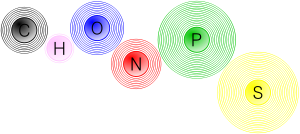- CHON
-
CHON (or CHNOPS) is an mnemonic acronym for the four most common (or six most essential) elements in living organisms: carbon, hydrogen, oxygen, and nitrogen. These four elements are also notable for being the least massive (and having the lowest atomic number) in their group in the periodic table.[not verified in body]
The acronym CHNOPS, which stands for carbon, hydrogen, nitrogen, oxygen, phosphorus and sulfur, the six important elements whose covalent combinations go to make up most biological molecules.[1] Sulfur is used in the amino acids cysteine and methionine.[2] Phosphorus is an essential element in the formation of phospholipids, a class of lipids that are a major component of all cell membranes as they can form lipid bilayers which keep ions, proteins and other molecules where they are needed for cell function and prevents them from diffusing into areas where they should not be.[3]
Excluding noble gases, the CHON elements are also some of the most abundant - carbon (4th most abundant), hydrogen (most abundant), oxygen (3rd) and nitrogen (6th). The other abundant elements, helium and neon, are both inert - they do not react with other elements.[citation needed]
Carbonaceous asteroids are rich in CHON elements.[4] These asteroids are the most common type and frequently collide with Earth as meteorites. Such collisions were especially common early in Earth's history and these meteorites may have been crucial in the formation of life on Earth.[citation needed]
Contents
CHON in science fiction
CHON is featured prominently in Frederik Pohl's Gateway which has an overpopulated Earth with 25 billion inhabitants. In this novel the protagonist starts out as an oil shale miner, with the oil being used as a feedstock for manufacturing synthetic food.[citation needed]
See also
References
- ^ Education (2010). "CHNOPS: The Six Most Abundant Elements of Life". Pearson Education. Pearson BioCoach. http://www.phschool.com/science/biology_place/biocoach/biokit/chnops.html. Retrieved 2010-12-10. "Most biological molecules are made from covalent combinations of six important elements, whose chemical symbols are CHNOPS. ... Although more than 25 types of elements can be found in biomolecules, six elements are most common. These are called the CHNOPS elements; the letters stand for the chemical abbreviations of carbon, hydrogen, nitrogen, oxygen, phosphorus, and sulfur."
- ^ Brosnan JT, Brosnan ME (June 2006). "The sulfur-containing amino acids: an overview". The Journal of Nutrition 136 (6 Suppl): 1636S–1640S. PMID 16702333. http://jn.nutrition.org/cgi/pmidlookup?view=long&pmid=16702333.
- ^ Campbell, Neil A.; Brad Williamson; Robin J. Heyden (2006). Biology: Exploring Life. Boston, Massachusetts: Pearson Prentice Hall. ISBN 0-13-250882-6. http://www.phschool.com/el_marketing.html.
- ^ Water vs. Rocks: Resources for Earth or for Exploration? SSI-TV video archive, recorded on 30 October 2010, 66:07, four talks and Q&A given during Session 2: Extraterrestrial Prospecting of the Space Studies Institute’s Space Manufacturing 14 conference in California. Prof. Michael A'Hearn (University of Maryland) @ 7:10 in the video. The video also includes Brad Blair, Space Studies Institute, and Prof. Leslie Gertsch, University of Missouri-Rolla: Mining Concepts Development for Accessing Asteroid Resources; Mark Sonter, Asteroid Enterprises Pty Ltd Resources: Asteroids: What We Can Expect From What We Know Now; Dr. Faith Vilas, University of Arizona, Department of Astronomy and Steward Observatory, accessed 2011-01-07.
External links
Categories:- Astrobiology
- Biology and pharmacology of chemical elements
- Mnemonics
- Science fiction themes
- Astrochemistry
Wikimedia Foundation. 2010.

